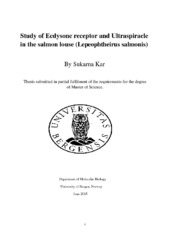Study of Ecdysone receptor and Ultraspiracle in the salmon louse (Lepeophtheirus salmonis)
Abstract
The salmon louse (Lepeophtheirus salmonis) is a parasite living on mucus, skin and blood of salmonids fishes. L. salmonis causes lesions and infections on fish fins and skins and such physical damages often lead to other diseases. The global salmon farming industry faces huge economic losses caused by the prevalence of salmon lice and is struggling to contain frequent salmon lice outbreaks. Chemical treatments have been a traditional way to combat salmon lice problem, but increased resistance of salmon lice to currently available chemicals leave the salmon aquaculture communities with fewer options. Therefore, it is warranted to search for new, efficient and environment-friendly drugs which are based on molecular studies of nuclear receptors of salmon lice. Investigation of ecdysone receptor (EcR), which acts as a receptor for the ecdosteroid hormone, is one of such molecule-based new drug searches. The ecdosteroid hormone plays an important role during molting, maturation and reproduction processes of crustaceans. Ecdysteroid agonists for EcR that disrupt these processes could be novel pesticides to control salmon lice. In this study, expression constructs of L. salmonis ecdysone receptor (EcR) and ultraspiracle (USP), which forms a heterodimer with EcR, were made and they were expressed in E. coli. The EcR constructs (both ligand- binding domain and full-length) were expressed well, but the full-length USP construct was not expressed. Immobilised metal ion affinity chromatography (IMAC) was used to purify EcR proteins. The two EcR proteins, i.e., ligand- binding domain (LBD) and full-length EcR, bound very poorly to the Ni-resin. The reason can be that the 6x His tag was buried inside of the MBP-attached EcR protein, thus it was not available to the Ni-resin. To circumvent this challenge, ion-exchange chromatography (IEC) was employed. At a very low salt concentration (6.7 mM NaCl), the EcR proteins were eluted as flowthrough, whereas much of impurities remained in the column, hence achieving substantial purification. As the last step of purification, size exclusion chromatography (SEC) was used. The proteins were eluted at near the void volume, suggesting they are in a form of aggregates under the experimental conditions. With partially purified EcR-LBD, a binding study between EcR-LBD using isothermal titration calorimetry (ITC) was attempted.
